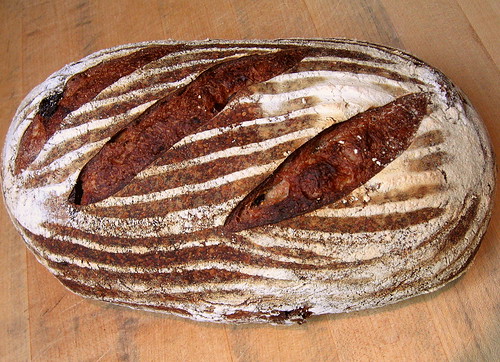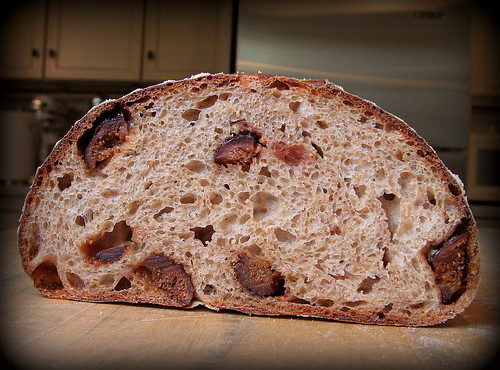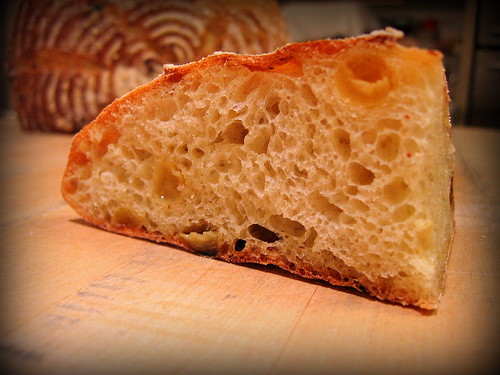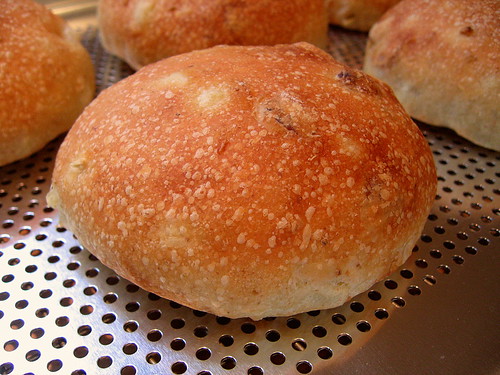Fennel has a very distinct, licorice-like flavor. Fennel, and its relative anise, tend to be polarizing. People seem to love or hate it. I am definitely on the side of loving it. My favorite way to eat raw fennel bulbs is thinly shaved and tossed with citrus segments and a citrus vinaigrette. I use the fennel fronds like any other fresh herb. A couple nights ago I combined fennel fronds, fresh rosemary, garlic, lemon zest, red pepper flakes, and crushed fennel seeds to rub onto a pork shoulder for slow-roasting. I even make a sweet 'n savory shortbread cookie that has fennel seeds, parmesan cheese and Maldon sea salt. It sounds strange, but it's an absolutely delicious cookie.
I bought a 2-pound bag of dried organic black mission figs from Costco a couple weeks ago and have been looking for an excuse to use it. Dabrownman posted his fig and fennel bread and I knew what I would bake.

The starting point for my fig and fennel bread formula was the Tartine basic country bread. I used 20% whole wheat flour and a levain that has fermented for 12-15 hours as opposed to Chad's 4-6 hour levain. The levain was built from my rye starter. I soaked my dried figs for 30 minutes in warm water and then drained them. I saved the fig soaking water to use in my dough. I would say my water was half fig soaking water and half from the tap.
I mixed everything except the salt and figs, let the dough rest in the bowl for 30 minutes, and then squeezed in the salt. I bulk fermented at 73F for 3.5 hours with stretches and folds. The figs were added during the second S&F. Shaped and retarded at 40F for 14 hours. Baked at 450F for 35 minutes with steam during the first 15 minutes.
Fig and Fennel Bread Grams (Bakers' Pct)
AP flour (Central Milling ABC) 480 (80%)
Whole wheat flour 120 (20%)
Water 450 (75%)
Salt 12 (2%)
Levain (100% hydration) 120 (20%)
Dried figs (soaked, drained & quartered) 200 (33%)
Fennel seeds (half ground, half crushed) 9 (1.5%)
----------------------------------------------------------------------------
Final Dough 1391 grams
Overall hydration: 77.2%
Prefermented flour: 9.1%

The bread was lovely. I thought that 33% figs would've been enough, but in hindsight I think I could have gone up to 50%. The crumb was not as open and hole-y as I wanted, but I guess if it was too open then the figs would fall out. The fennel seed flavor was quite assertive since I ground half the seeds into a powder before adding it to the dough. I left the other half crushed. The flavor was well distributed throughout the bread and I could taste it in every bite. Fennel and figs really work well together.

The other fennel bread I baked is a semolina, golden raisin and double fennel bread. I stole the flavor combination from Amy's Bread in NY. The dough is based on the semolina sesame bread (pane siciliano) that I learned at the San Francisco Baking Institute. There's a tiny bit of instant dry yeast in this dough. The instructor at the SFBI said it's a bit of insurance since a naturally leavened semolina dough can be a bit tricky.
I used some fennel bulb as well as fennel seeds. I sliced the bulb, blanched it for 2 minutes, drained and chopped it. I ground all the fennel seeds into a powder. I soaked the golden raisins for about 15 minutes in warm water and then drained them.
I combined everything except the raisins and chopped fennel and mixed for 2 minutes on speed 1 of my KitchenAid stand mixer. I added the raisins and fennel and mixed for 1 minute. I transferred the dough to a lightly oiled container and bulk fermented at 70F for 3 hours with a set of stretches and folds at 60 and 120 min. I divided the dough into two halves. I shaped six 100-gram rolls with one half and a boule with the other. The boule was proofed for 2 hours and the rolls for 1.5 hours (room temp ~70F). The boule was baked at 450F for 35 minutes with steam during the first 15 minutes. The rolls were baked at 425F for 20 minutes.


Semolina, Raisin, and Fennel Grams (Bakers' Pct)
AP flour (Central Milling ABC) 250 (50%)
Semolina flour 250 (50%)
Water 340 (68%)
Olive oil 25 (5%)
Salt 12 (2.4%)
Instant dry yeast (SAF red) 0.5 (0.1%)
Levain (100% hydration) 125 (25%)
Golden raisins (soaked & drained) 115 (23%)
Fennel seeds (ground) 5 (1%)
Fennel bulb (sliced, blanched & chopped) 115 (23%)
------------------------------------------------------------------------------
Final Dough 1237.5 grams
Overall hydration: 71.6%
Prefermented flour: 11.1%

My boule stuck to the brotform and deflated quite a bit as I worked it out of the form. The ovenspring was not enough to overcome the deflation. The rolls came out perfectly.

I loved the sweet golden raisins with the flavor of the semolina. The fennel seed was detectable, but not assertive. It was the perfect amount. The fennel bulb wasn't worth the effort. It was hardly noticeable and I would probably leave it out the next time I make this bread.
:) Mary